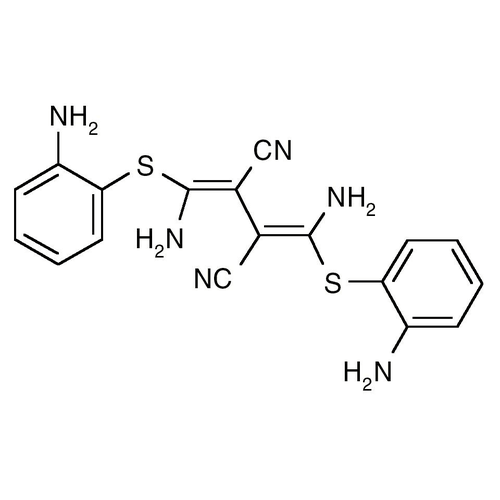Specifications
SHIPPING NOTES
Shipped Ambient. All orders received in North America by 12:00 PM PST Monday to Thursday will usually be shipped out on the same day. North American customers will typically receive their orders within 1-2 business days. All shipments are F.O.B. from point of shipment, pre-paid and added to the invoice. Freight charges include but not limited to: priority service and packaging materials.Products are shipped with “cold packs” in insulated containers. There is a charge for this packaging and for the shipping costs via FedEx. Please inspect packages immediately upon receipt and inform Labscoop Customer Support of any shortage or damage within 48 hours of receipt. We can only accept returns after we have given prior authorization and issued specific shipping instructions. If a customer wishes to use their own FedEx account number please indicate this on the purchase order or during checkout.
SMILES
C2=C(SC(/N)=C(/C(=C(SC1=CC=CC=C1N)\N)C#N)C#N)C(=CC=C2)N
INCHI KEY
DVEXZJFMOKTQEZ-JYFOCSDGSA-N
*USAGE / SAFETY STATEMENT
Not for use in humans. Not for use in diagnostics or therapeutics. For in vitro research use only.
QUALITY CERTIFICATION / COMPLIANCE
ISO 9001:2015
SCIENTIFIC BACKGROUND
U-0126 is a novel, potent and selective MEK inhibitor (MEK1; IC50=72nM, MEK2; IC50=58nM). Inhibits AP-1 transcription activity. Blocks the production of inflammatory cytokines and matrix metalloproteinases.
Binding of extracellular growth factors to cell surface receptors often results in activation of the mitogen-activated protein kinase (MAPK). MAPK is regulated by MAPK kinase, also called MEK. Deprivation of growth factors during cell culture or intracellular MEK inhibition leads to inhibition of proliferation and apoptotic cell death. N Blank et al. (2002) have shown that U0126, a common used MEK inhibitor and compound that itself has no intrinsic fluorescence in vitro but develops an intensive fluorescence during cell culture which can be observed in all fluorescence channels with predominance in the FL1 channel (525nm).
REFERENCES
1. Duncia J.V., et a.l (1998) Bioorg. Med. Chem. Lett. 8(20): 2839-44.
2. Favata M.F., et al. (1998) J. Biol. Chem. 273(29): 18623-32.
3. Davies S.P., et al. (2000) Biochem. J. 351(Pt1): 95-105.
4. Namura S., et al. (2001) Proc. Natl. Acad. Sci. U.S.A. 98(20): 11569-74.
RESEARCH AREA
Cell Signaling
ALTERNATIVE NAMES
1,4-Diamino-2,3-dicyano-1,4-bis[2-aminophenylthio]butadiene


